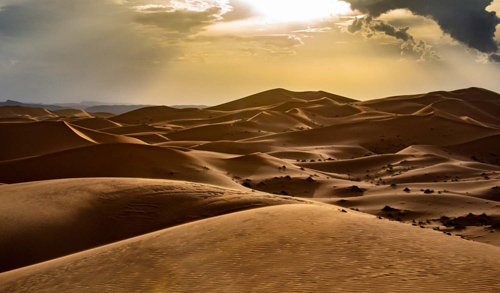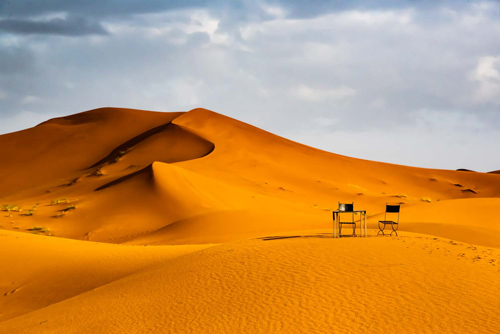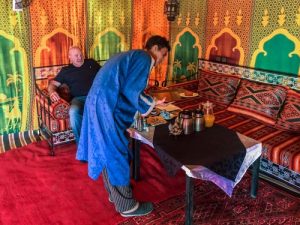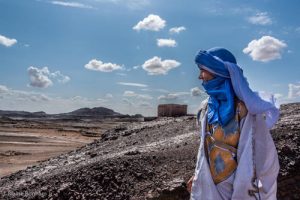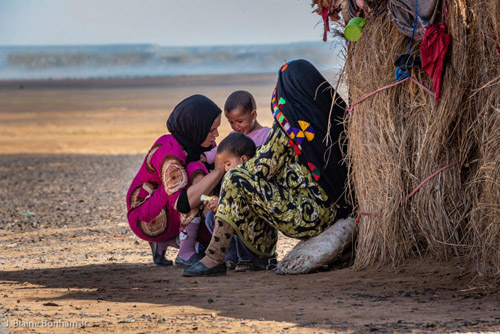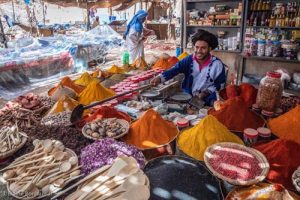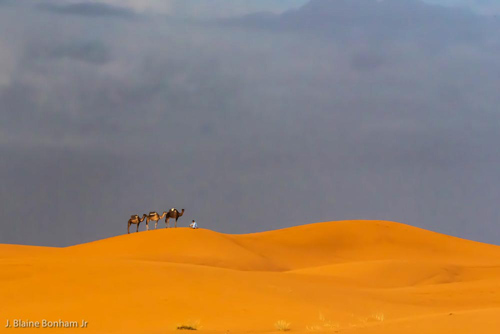Travel Mag
By Blaine Bonham
“Yee Haw!” It bursts from my mouth. Hamid plunges the Toyota four-wheel drive down the embankment and through a two-foot deep flash river that formed during the night. The bone-dry desert floor repelled torrential rains, forcing water into dry gullies gushing across the landscape. A wall of muddy water momentarily obscures our vision, then settles down to paint the car in a coat of sand water as we climb out of the stream. Our driver on the 11-day Moroccan adventure is taking my partner Rick and me to visit a nomad family’s home.
We headed out earlier after a good night’s sleep glamping in a cozy tent and indulging in a tummy-warming Berber breakfast at Countryside Morocco Tours’ Moonlight Desert Camp. Nestled in Erg Chebbi, a sea of semi-arid sand dunes at the edge of the Western Sahara Desert, a sense of solitude pervades. The desert receives only four inches of rain annually, but sudden downpours happen occasionally. An impressive cloudburst greeted us at dusk yesterday when we arrived.
Once the bottom of a sea millions of years ago, the flat desert floor runs west and north for miles to the Atlas Mountains. To the east and south, sand dunes stretch across North Africa. Any serious digging here produces fossils of extinct sea life. At every popular promontory or abandoned village where tour drivers stop for picture-taking, men sell raw and polished fossil trinkets, and other inexpensive local crafts. Enterprising artisans established sophisticated businesses in a nearby town to excavate fossils and create elaborate home furnishings—kitchen and bathroom fixtures, fountains, and works of art—to ship worldwide.
Visiting Nomads of the Moroccan Desert
Most of Morocco’s population of 33 million consider themselves a Berber-Arab-Andalusian (Spanish Muslim) origin. Arabs invaded and conquered the original Berber inhabitants in the seventh century. While the two cultures blended over centuries, the Berber clans especially in the Rif Mountains in northern Morocco and in the Middle Atlas Mountains and Western Sahara remained separate from other ethnic peoples. Known as Tuareg Berbers throughout North African countries, they trace their roots to a group called the A-mazigh, or “free people.” Their identifiably Tuareg indigo-dyed clothes also color their skin. They are dubbed “blue men,” a name they wear proudly.
Hamid’s family is Berber Tuareg. He wears a blue turban, called a cheche, and dresses us each in blue cheches, our headgear for the two-day desert visit. We are now honorary blue men. He gives us Berber names –Hassan for Rick and Moha for me.
Except for the narrow macadam road that cuts straight across the desert towards a dead end in the middle of nowhere, no other formal roads exist in the black-streaked sandy, flat expanse. Hamid sometimes follows well-worn tire tracks of other local tour vehicles. Mostly he strikes out on unmarked terrain, occasionally scaling small drifts of sand like a cowboy and his horse jumping a fence. Sparsely scattered in the distance on the old sea floor, evidence of nomadic life appears around clusters of makeshift tents.
We pull up to a Berber family’s encampment of several large and small makeshift structures. Hamid greets the woman and her son warmly: her family has given him permission to bring travelers there to get a first-hand look at a nomadic household. Mom and toddler greet us. We exchange nods and phrases not understood, and she retreats to do chores and he to play. The husband and another older boy aren’t here; they travel several miles a day to the desert’s edge with the sheep, goats, and donkeys so the animals can forage for food and water.
Two main tents make up what appears to be family living quarters. One serves as a day and dining room; the other larger structure sleeps the family of four. Camel and goat hair blankets, with straw for insulation and a layer of blue plastic tarp to repel rain from sudden squalls, are the tents’ chief building materials. Washed clothes spread over them to dry. Small additional enclosures house a handmade clay oven for baking bread, a fire pit for cooking, and a storage bin for foodstuffs. Barley couscous, milk, tea, bread, dates, and meat from the goat or sheep herds comprise the Berber diet.
We settle cross-legged on rugs in the day tent, where a pot of heavily sugared hot mint tea and three glasses await us. Hamid does the honors of the ceremonial tea pouring, pot held high in one hand, cup in the other, a stream of light-colored liquid squarely hitting the bottom of each glass as he raises and lowers the pot. From my seated position, the tent’s open side flaps give me a dog’s eye view of the sweeping landscape. Last night’s torrent cleared the air and produced a fresh crisp scent. Cloudless sky meets distant mountain ridges, as the intense sun heats the day. It is late September, and the day’s temperature will reach a dry 90 degrees. No sound interrupts the quiet, except our own voices.
Hamid’s parents gave up nomadic life when he was born, the sixth of 10 children, and settled in a nearby town. His father learned a construction trade and built the family house. Hamid’s two younger sisters attended school and completed a general education, the first for anyone in the family. His aunts and uncles also settled their families into sedentary life over time, part of a trend in recent years among nomads of the Western Sahara.
The thirst to learn among young people drives this cultural upheaval, gradually ending a traditional way of life for nomads. When families decide to school their children, they must stay at their own encampments in the desert nearby for much of the year. This delays the annual spring migration to the mountains for cooler weather and greener pastures for livestock until school is finished. Many families carry solar panels with them to power cell phones, radios, and lamps for nighttime. Others who have settled in permanent homesteads still travel to the mountains with their families and animals in the summer and return home when school starts.
We finish a second cup of tea. A neighboring mother and her child walk from a distant encampment to visit our host and her son. The children play together and argue with each other—as children do everywhere—leaving our host’s child in tears. As we leave, I give the mother several dirhams, Morocco’s currency, as a thank you. I have briefly touched a world alien to me. I feel awkward and unsure of myself.
Shopping at Rissani’s Wednesday Market
Hamid pilots the mud-covered Toyota west across the desert to Rissani, a former caravan center known for its leather and goat skin trade. Risanni is the closest town of size to Erg Chebbi, and its lively Wednesday market is our destination. Plunging into the crowds inside the roofed souk in our blue turbans, our conspicuous presence attracts a few stares.
Shoppers and shopkeepers clog the aisles. The immediate assault on the senses snaps us from our hypnotized desert mindset. Kaleidoscopic vegetable stands piled high with tomatoes, peppers, eggplants, melons, oranges, grapes, squashes, and carrots give way to stalls of slaughtered sheep and goats in varying degrees of dismemberment. Butchers nicely arrange hearts, brains, and kidneys on tables and hang body parts on hooks overhead so prospective buyers can take a close look at the goods. Flies also enjoy the display. A row of severed goat heads stare up at passers-by; the tongue of one head lolls outside its mouth as if the whole ordeal was just too much.
Stands of household items, colorful shawls and blankets, cheap clothing, small electronics, and a junk shop of scrap metal and machine bits and pieces each have a devoted aisle. Vivid cones of spices and herbs – turmeric, paprika, cumin, coriander, saffron, ground ginger, pepper – lavish their vibrant colors on my senses.
What’s this? A sprawling date market! Early fall is date harvest time. Aisles of stands stacked high with cartons surround a large square floor. The date palm is the “tree of life” in Islam, and Muslims eat dates to break the fast during Ramadan. Piles of dark brown medjool dates on rugs and burlap cover the area. Buyers and sellers, all men, engage in the bargaining, as bees and yellow jackets buzz around the sticky fruit. The air intoxicates with heavy scents. Hamid purchases a box of dates, and I pop two into my mouth quickly, tasting the flavors of honey, caramel, and cinnamon.
After a visit to the “donkey parking lot” where merchants and buyers leave their animals during market hours, we head back across the flat desert floor towards Erg Chebbi. Two camels and their driver wait to take us on an adventure.
Sailing the Erg Chebbi Dunes
I have never tried one of those mechanical bulls at amusement parks that whip riders all over the place, before flinging them to the ground. Is it like the motion my body undergoes next, as the seated animal on which I precariously straddle raises herself first on her hind legs, then straightens her front legs? Unprepared for the experience, I am tossed violently frontward, then backward. I barely manage to hang on. These camels (one-humped dromedaries, scientifically speaking) stand six feet tall, so passengers have a long way to fall, although the landing pad of sand is a soft one.
I have patiently waited all day for this sunset cruise on a “Ship of the Desert.” Our camel driver Ishmael sets out on foot between two imposing dunes with his two beasts and their burdens. Soon only sand, sky, and the rump of the camel in front of me occupy my vision.
Except for the soft swish of camel toes plying sand, absolute quiet reigns. I find it a challenge to grip the animal’s sides with my thighs and hold tightly the rope wrapped around her body. Soon I adapt to the rocking motion of my camel’s gait. I notice the sunglasses once strung around my neck have disappeared. I try to look behind me, but the trail and its shadows have already swallowed them.
The curved, undulating lines of dune ridges mesmerize; nothing in this empty landscape is manmade. Nature’s color wheel comes to mind with the complementary brilliant blue of the sky and amber hue of the sand. I am awestruck. My inner voice purrs contentment.
Around the next dune, we join another camel driver and a pair of dromedaries with passengers. Each female rider is wrapped in a hooded desert travel garment – one dazzling white, the other a brilliant red – mysterious visions against the golden sand. Their train peels off as shadows lengthen.
We arrive at a wide gap between soaring dunes. At our driver’s command, the camels fold their legs to sit down, and my body repeats the whiplash, though this time I’m more prepared. Ishmael suddenly sprints up the face of the largest dune, about 150 feet high, and beckons us to follow. I zigzag up the slope to ease the climb, filling my shoes with sand along the way. Panting, I reach the top of the ridge. Vistas of undulating dunes appear in all directions, as well as four other caravans of drivers and travelers. Apparently, this is prime sunset-watching real estate. Others climb our dune and surrounding peaks. (And I thought this dune was our private domain!) Dutch, Chinese, and Australians join us for the show. In the distance, I see the tent tops of several campsites.
Colors shift and shadows grow and deepen, as the sun slips close to the horizon. The moment is magical.
We make a quick descent, endure one last body-thrashing as the camels stand, and head off for a short trek back to Camp Desert Moonlight. We have traveled almost five kilometers.
After a sumptuous Berber dinner of goat, vegetable tagine, and cous cous, we join six Chinese guests around the campfire. The camp staff greets us with their musical instruments – mostly percussive, plus a loutar, a stringed affair – for a nighttime serenade. Two of the guests are the enigmatic white and red visions we traveled with briefly on our desert cruise. After a rousing set of village-style melodies, all sounding similar to my untrained ear, the musicians want all of us to play them and attempt some fashion of musical concert. That does not go well, though it’s fun trying.
The night is clear. The sky is littered with millions of stars. Faces of players and guests glow with the reflection of the dancing flames. It’s practically midnight at the oasis.




